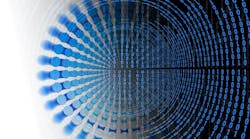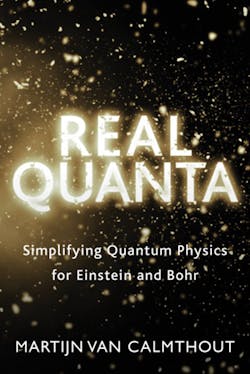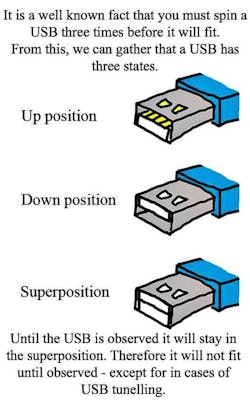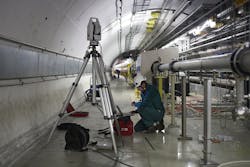Quantum physics, in short, is the science of small things. While Newtonian physics is perhaps more comfortable to us, things can get weird when we start looking at particles. I’ll spare a lot of details, but I’ve heard lackluster reviews from my hero Neil DeGrasse Tyson’s new book Astrophysics for People in a Hurry. I’m hoping the soon-to-come-out Real Quanta: Simplifying Quantum Physics for Einstein and Bohr” by Martijn van Calmthout proves to be more detailed.
In “Real Quanta,” van Calmthout sits down at the famous Hotel Métropole in Brussels with Albert Einstein and Niels Bohr to catch them up on the progress that's happened in quantum mechanics since they, well, died. He shows that although quantum physics is strange, it is certainly not the exclusive domain of a handful of smart physicists.
“Quantum mechanics is not something that just exists on paper,” says van Calmthout. “It is perfectly real and is a crucial part of what makes the modern world possible.” In fact, the email that grabbed my attention to this new book had the subject line, “Even Beer Has a Pinch of Quantum Flavor: Simplifying Quantum Physics for Einstein and Bohr.”
Calmthout continued, “Scientists around the world are working on creating a quantum computer that can run faster than any known supercomputer and can run simultaneous calculations. Quantum cryptology, a special form of electronic encryption, is already being used in the banking world. Quantum mechanics powers everyday things like the smart phone in your pocket. And quantum is not just powering our gadgets; it is even present in the birds in your gardens and the leaves in your trees.”
While I look forward to reviewing this book, it did remind me of a few simple explanations I’d like to share. Like most explanations along these lines, you’ll have to have a bit of a sense of humor, and some grains of salt. I’ll spare you the double slit experiment and flatland, as I feel the videos from, “What the Bleep Do We Know,” does a great job of explaining them:
Superpositioning
Many people are familiar with Schrödinger’s cat. If you put a cat in a box with a vile of poison that randomly breaks open, the cat can be thought of as both alive and dead. This was obviously before PETA was formed, and doesn’t address position in a way a person might see it.
This is why I loved the superposition explained through a USB. We’ve all probably tried to plug in a USB, eventually rotated it 180 degrees, and still not be able to plug it in. Then we look at it to see what position it is in, and, finally, it fits.
With the idea of superposition, the USB exists in both positions at once. Only after you observe the USB do you collapse the wave function (a reference to the double slit experiment, see video above) and give it a position to plug it in.
USB superposition: This image comes by way of Credit Bram.us. (Note: We realize the spelling of “tunneling” is incorrect, and should be “tunneling”.)
Quantum Computing
Another explanation I’ve heard was a simple way to think of quantum computing. If computers run off of ones and zeros that could be thought of as a yes or no, a quantum computer adds a “maybe” to the mix. The problem with this is a “maybe” probably won’t help you stream TV faster from the internet.
Quantum physics is probabilistic. This means it’s great for experiments, not everyday applications for me and you. However, scientists think it will help with weather predictions, or help answer questions that, at this time, may seem random to us.
I like to mention that quantum computing is like the probability drive in the Heart of Gold, a spaceship in The Hitchhiker’s Guide to the Galaxy. If you are unfamiliar with this book (or movie), this video will help explain it:
Computers have operated off of ones and zeros called bits. A quantum computer runs on quantum bits. These are particles magnetically suspended in extreme cold. The idea is to capture the particle in a state of superposition; essentially the particle is a one and a zero at the same time. Scientists believe this will offer speeds like we’ve never seen before. Currently, we have quantum computers, but they aren’t showing signs of this acceleration.
Some feel that this is only a theoretical idea that can’t be applied. However, a lot of big players like Google and Microsoft are grabbing as many top scientists as they can and investing heavily into the idea that it is possible—they just have to figure out how. Some predictions say that we should have computers that offer this quantum speed-up sometime in the next 10 years.
The Super Proton Synchrotron (SPS), pictured during a recent technical stop. (Image: Max Brice/CERN)
Finally, in other quantum-related news, CERN was recently fired up again. It looks like the machine is moving particles faster and providing more collisions than ever. Everything looks promising for the machine to be alive and collecting data by spring 2018.
In conclusion, explaining high-end science to the masses will continue to have to be simple, accurate, and entertaining… or at least digestible. Communicating these explanations to the people and creating excitement about science will help places like NASA and our National Laboratories receive funding.
Perhaps if the U.S. could have excited people about science more, America could have been the country to discover the Higgs boson particle. In 1993, the U.S. Congress killed a project to build a large Hadron collider that could have found the Higgs boson particle years before the Europeans. Now all that’s there is one big expensive hole in the ground. Scientific American has a great article on it.
If you want to see the groundbreaking work that has happened at CERN, watch Particle Fever. It’s available on Netflix, or simply watch it here:




